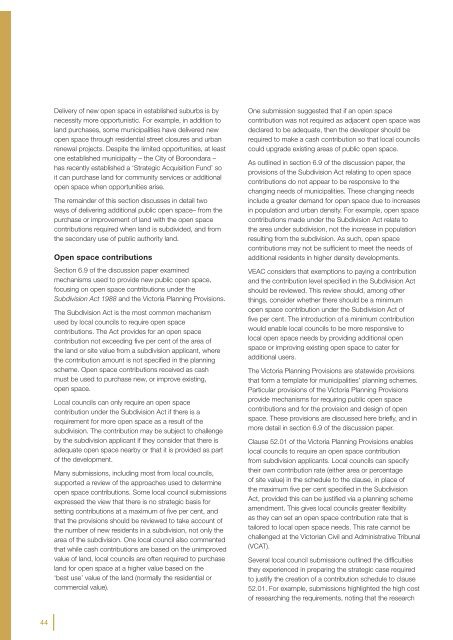Metropolitan Melbourne Investigation - Victorian Environmental ...
Metropolitan Melbourne Investigation - Victorian Environmental ...
Metropolitan Melbourne Investigation - Victorian Environmental ...
Create successful ePaper yourself
Turn your PDF publications into a flip-book with our unique Google optimized e-Paper software.
Delivery of new open space in established suburbs is by<br />
necessity more opportunistic. For example, in addition to<br />
land purchases, some municipalities have delivered new<br />
open space through residential street closures and urban<br />
renewal projects. Despite the limited opportunities, at least<br />
one established municipality – the City of Boroondara –<br />
has recently established a ‘Strategic Acquisition Fund’ so<br />
it can purchase land for community services or additional<br />
open space when opportunities arise.<br />
The remainder of this section discusses in detail two<br />
ways of delivering additional public open space– from the<br />
purchase or improvement of land with the open space<br />
contributions required when land is subdivided, and from<br />
the secondary use of public authority land.<br />
Open space contributions<br />
Section 6.9 of the discussion paper examined<br />
mechanisms used to provide new public open space,<br />
focusing on open space contributions under the<br />
Subdivision Act 1988 and the Victoria Planning Provisions.<br />
The Subdivision Act is the most common mechanism<br />
used by local councils to require open space<br />
contributions. The Act provides for an open space<br />
contribution not exceeding five per cent of the area of<br />
the land or site value from a subdivision applicant, where<br />
the contribution amount is not specified in the planning<br />
scheme. Open space contributions received as cash<br />
must be used to purchase new, or improve existing,<br />
open space.<br />
Local councils can only require an open space<br />
contribution under the Subdivision Act if there is a<br />
requirement for more open space as a result of the<br />
subdivision. The contribution may be subject to challenge<br />
by the subdivision applicant if they consider that there is<br />
adequate open space nearby or that it is provided as part<br />
of the development.<br />
Many submissions, including most from local councils,<br />
supported a review of the approaches used to determine<br />
open space contributions. Some local council submissions<br />
expressed the view that there is no strategic basis for<br />
setting contributions at a maximum of five per cent, and<br />
that the provisions should be reviewed to take account of<br />
the number of new residents in a subdivision, not only the<br />
area of the subdivision. One local council also commented<br />
that while cash contributions are based on the unimproved<br />
value of land, local councils are often required to purchase<br />
land for open space at a higher value based on the<br />
‘best use’ value of the land (normally the residential or<br />
commercial value).<br />
One submission suggested that if an open space<br />
contribution was not required as adjacent open space was<br />
declared to be adequate, then the developer should be<br />
required to make a cash contribution so that local councils<br />
could upgrade existing areas of public open space.<br />
As outlined in section 6.9 of the discussion paper, the<br />
provisions of the Subdivision Act relating to open space<br />
contributions do not appear to be responsive to the<br />
changing needs of municipalities. These changing needs<br />
include a greater demand for open space due to increases<br />
in population and urban density. For example, open space<br />
contributions made under the Subdivision Act relate to<br />
the area under subdivision, not the increase in population<br />
resulting from the subdivision. As such, open space<br />
contributions may not be sufficient to meet the needs of<br />
additional residents in higher density developments.<br />
VEAC considers that exemptions to paying a contribution<br />
and the contribution level specified in the Subdivision Act<br />
should be reviewed. This review should, among other<br />
things, consider whether there should be a minimum<br />
open space contribution under the Subdivision Act of<br />
five per cent. The introduction of a minimum contribution<br />
would enable local councils to be more responsive to<br />
local open space needs by providing additional open<br />
space or improving existing open space to cater for<br />
additional users.<br />
The Victoria Planning Provisions are statewide provisions<br />
that form a template for municipalities’ planning schemes.<br />
Particular provisions of the Victoria Planning Provisions<br />
provide mechanisms for requiring public open space<br />
contributions and for the provision and design of open<br />
space. These provisions are discussed here briefly, and in<br />
more detail in section 6.9 of the discussion paper.<br />
Clause 52.01 of the Victoria Planning Provisions enables<br />
local councils to require an open space contribution<br />
from subdivision applicants. Local councils can specify<br />
their own contribution rate (either area or percentage<br />
of site value) in the schedule to the clause, in place of<br />
the maximum five per cent specified in the Subdivision<br />
Act, provided this can be justified via a planning scheme<br />
amendment. This gives local councils greater flexibility<br />
as they can set an open space contribution rate that is<br />
tailored to local open space needs. This rate cannot be<br />
challenged at the <strong>Victorian</strong> Civil and Administrative Tribunal<br />
(VCAT).<br />
Several local council submissions outlined the difficulties<br />
they experienced in preparing the strategic case required<br />
to justify the creation of a contribution schedule to clause<br />
52.01. For example, submissions highlighted the high cost<br />
of researching the requirements, noting that the research<br />
44
















